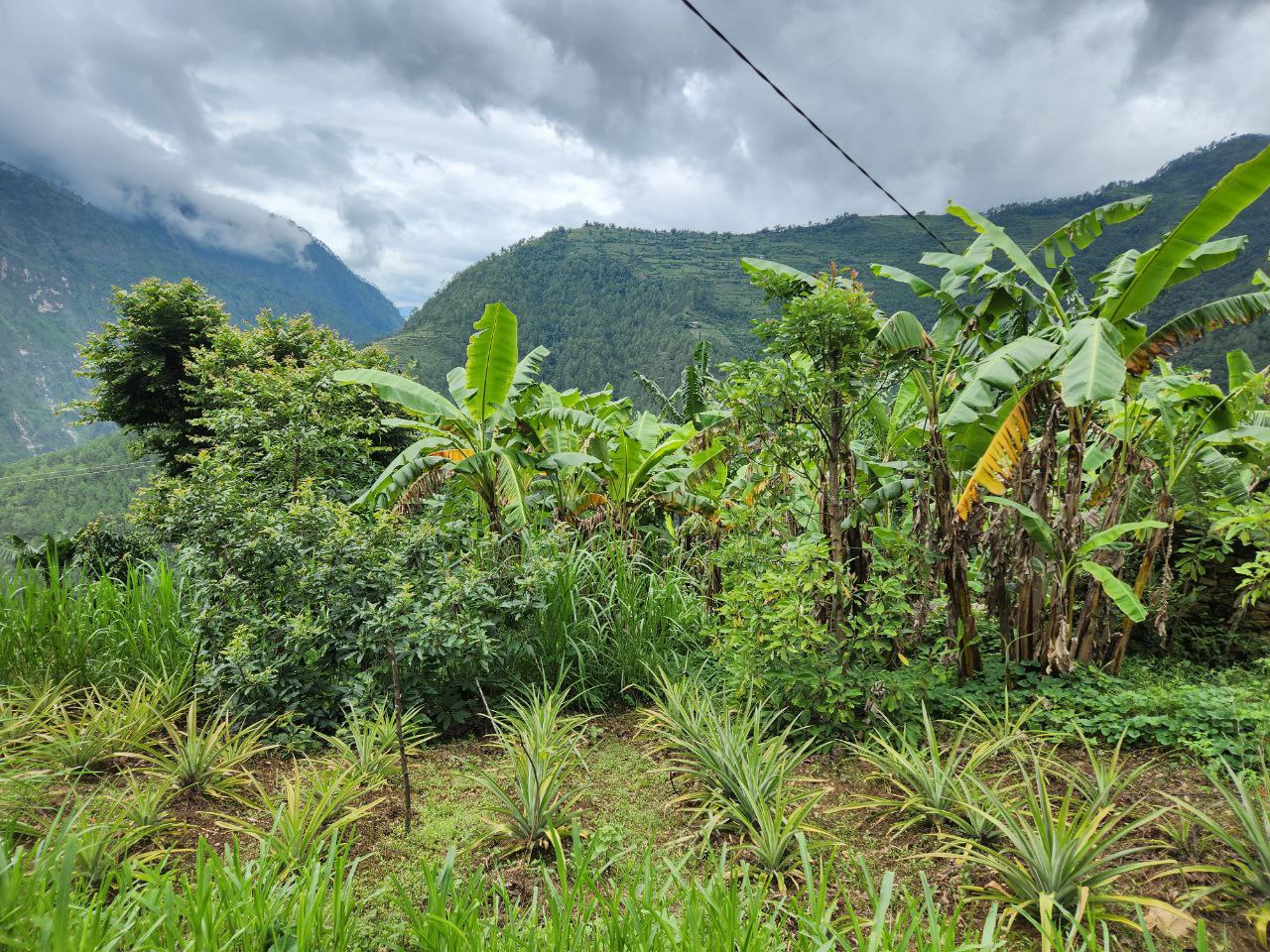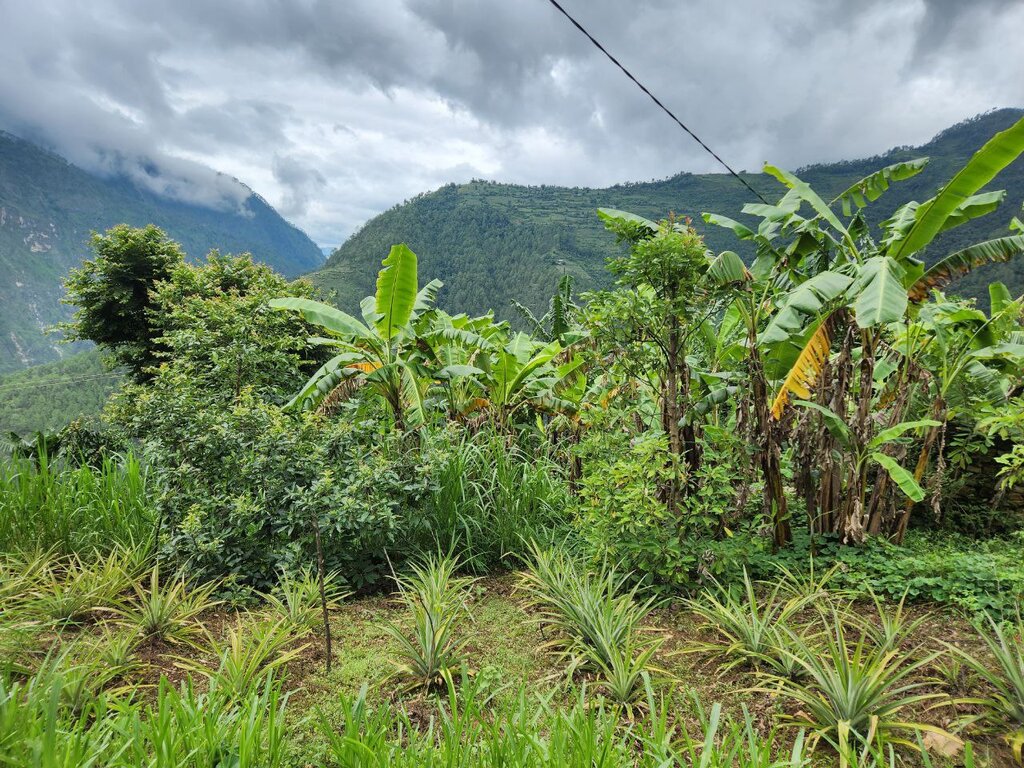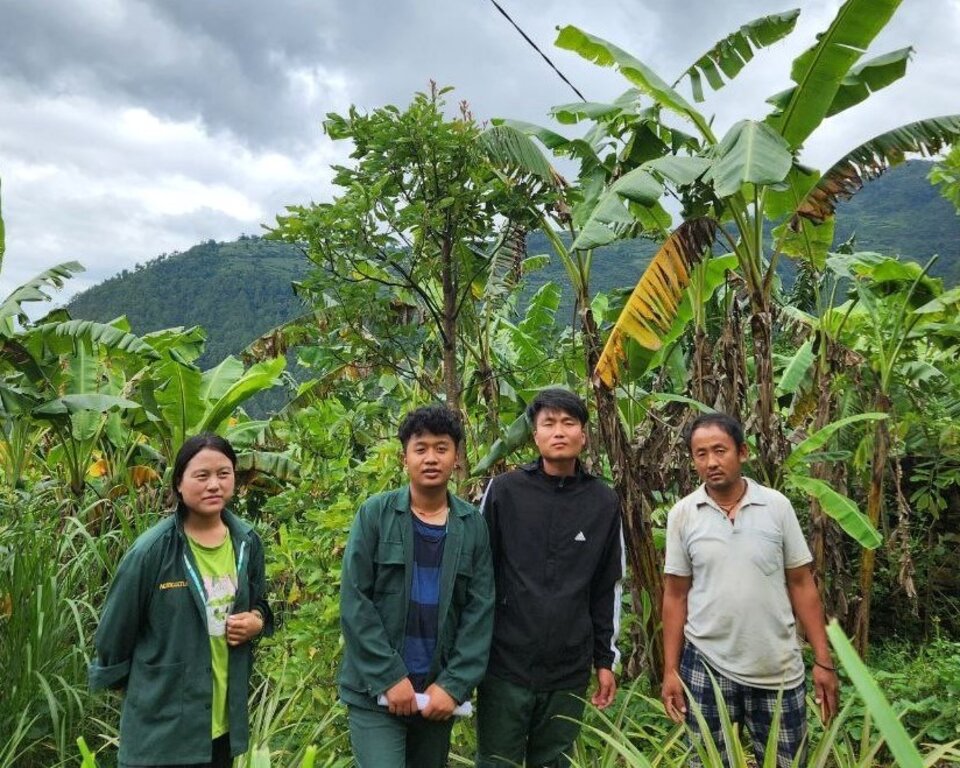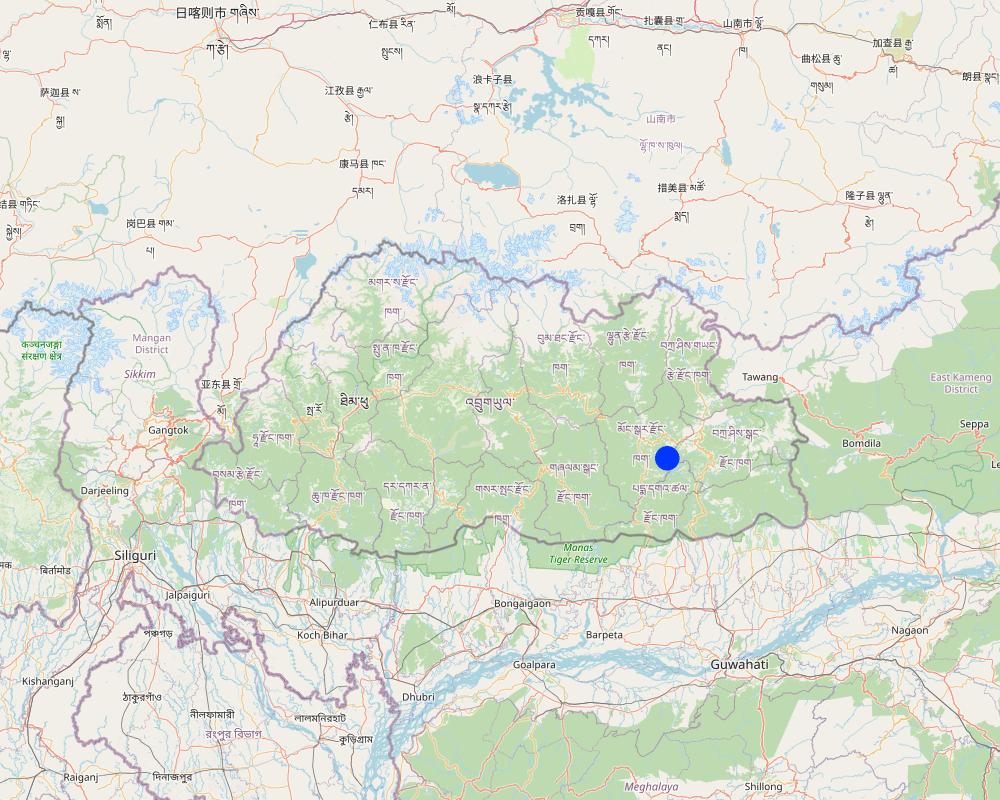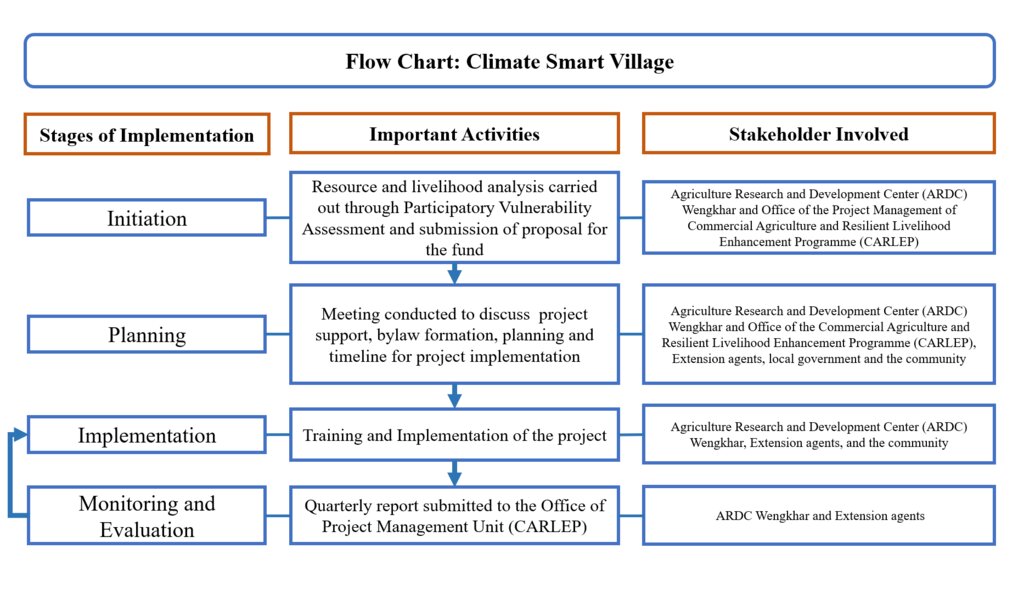Climate-Smart Village Approach [ប្រទេសប៊ូតង់]
- ការបង្កើត៖
- បច្ចុប្បន្នភាព
- អ្នកចងក្រង៖ ONGPO LEPCHA
- អ្នកកែសម្រួល៖ –
- អ្នកត្រួតពិនិត្យច្រើនទៀត៖ William Critchley, Rima Mekdaschi Studer, Joana Eichenberger
Namshi Thuendrel Gi Yue (གནམ་གཤིས་མཐུན་འབྲེལ་གྱི་གཡུས།)
approaches_6852 - ប្រទេសប៊ូតង់
ពិនិត្យមើលគ្រប់ផ្នែក
ពង្រីកមើលទាំងអស់ បង្រួមទាំងអស់1. ព័ត៌មានទូទៅ
1.2 ព័ត៌មានលម្អិតពីបុគ្គលសំខាន់ៗ និងស្ថាប័នដែលចូលរួមក្នុងការវាយតម្លៃ និងចងក្រងឯកសារនៃវិធីសាស្ត្រផ្សព្វផ្សាយ
បុគ្គលសំខាន់ម្នាក់ (ច្រើននាក់)
អ្នកប្រើប្រាស់ដី:
Yangki Karma
77211775
Ngaru-Pongtang village
Ngaru-Pongtang village, Thangrong gewog (block), Mongar Dzongkhag (district), Bhutan
ប្រទេសប៊ូតង់
អ្នកប្រើប្រាស់ដី:
Lhaden Sanga
77625788
Ngaru-Pongtang village
Ngaru-Pongtang village, Thangrong gewog, Mongar Dzongkhag, Bhutan
ប្រទេសប៊ូតង់
អ្នកប្រើប្រាស់ដី:
Lhendup
17526138
Ngaru-Pongtang village
Ngaru-Pongtang village, Thangrong gewog, Mongar Dzongkhag, Bhutan
ប្រទេសប៊ូតង់
ឈ្មោះគម្រោងដែលបានចងក្រងឯកសារ/ វាយតម្លៃលើវិធីសាស្ត្រផ្សព្វផ្សាយ (បើទាក់ទង)
Strengthening national-level institutional and professional capacities of country Parties towards enhanced UNCCD monitoring and reporting – GEF 7 EA Umbrella II (GEF 7 UNCCD Enabling Activities_Umbrella II)ឈ្មោះអង្គភាពមួយ (ច្រើន) ដែលបានចងក្រងឯកសារ/ វាយតម្លៃលើវិធីសាស្ត្រផ្សព្វផ្សាយ (បើទាក់ទង)
National Soil Services Centre, Department of Agriculture, Ministry of Agriculture & Livestock (NSSC) - ប្រទេសប៊ូតង់1.3 លក្ខខណ្ឌទាក់ទងទៅនឹងការប្រើប្រាស់ទិន្នន័យដែលបានចងក្រងតាមរយៈវ៉ូខេត
តើពេលណាដែលទិន្នន័យបានចងក្រង (នៅទីវាល)?
15/07/2023
អ្នកចងក្រង និង(បុគ្គលសំខាន់ៗ)យល់ព្រមទទួលយកនូវលក្ខខណ្ឌនានាទាក់ទងទៅនឹងការប្រើប្រាស់ទិន្នន័យដែលបានចងក្រងតាមរយៈ វ៉ូខេត:
បាទ/ចា៎
1.4 ការយោងមួយ (ច្រើន) ទៅលើ (កម្រង) បញ្ជីសំណួរនៃបច្ចេកទេស SLM
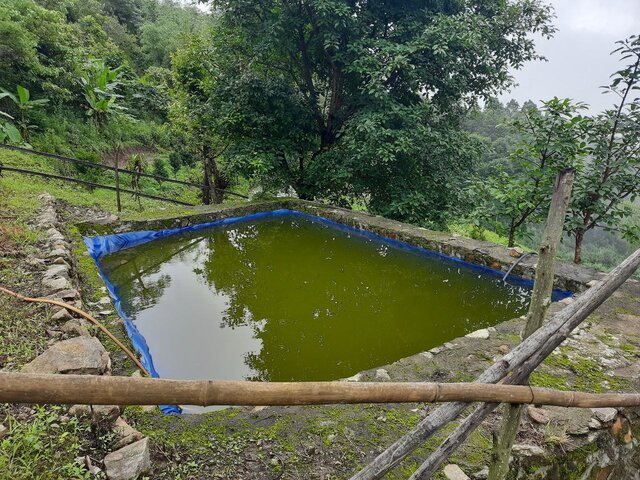
Low-Cost Plastic-Lined Water Harvesting Pond [ប្រទេសប៊ូតង់]
Low-cost plastic-lined water harvesting ponds collect and store rain and overland flow water for agricultural and domestic purposes in the dry season. They are both economic and efficient.
- អ្នកចងក្រង៖ Nima Dolma Tamang
2. ការពណ៌នាអំពីវិធីសាស្ត្រផ្សព្វផ្សាយ SLM
2.1 ពណ៌នាសង្ខេបខ្លីពីវិធីសាស្ត្រផ្សព្វផ្សាយ
Climate change has become inevitable, and there is a need to address this impending danger. In the Climate-Smart Village (CSV) approach, land users in Ngaru-Pongtang have implemented several technologies and innovations to address climate change impacts, and the programme has worked with 50 households on a total area of 137 acres (55 ha).
2.2 ពណ៌នាលម្អិតពិវិធីសាស្ត្រផ្សព្វផ្សាយ
ពណ៌នាលម្អិតពិវិធីសាស្ត្រផ្សព្វផ្សាយ:
This approach focused on transforming Ngaru-Pontang into a Climate-Smart Village (CSV) with actions that also contribute to mitigating climate change. The programme has worked with 50 households on a total area of 137 acres (55 ha). The approach included a participatory vulnerability assessment, and extensive training and education for the land users. They were equipped with skills, technologies, and innovative practices related to climate-smart agriculture (CSA). Additionally, the approach emphasized collaborative efforts, working closely with community members to foster better engagement and cooperation.
The primary objectives of the approach were to transform Ngaru-Pontang village into a CSV and thus effectively address the challenges posed by climate change. To achieve these goals, the approach employed various methods. It involved meetings with the community members, vulnerability assessment, fostering collaboration between the community, Agriculture Research and Development Centre (ARDC) Wengkhar, and Commercial Agriculture and the Resilient Livelihood Enhancement Programme (CARLEP). The community members received comprehensive training and attended workshops on climate-smart agriculture practices.
The implementation of the approach adopted the following stages:
1. Resource and livelihood analysis carried out through a Participatory Vulnerability Assessment.
2. Based on the findings from the above assessment, a project proposal was submitted to secure funding.
3. Subsequently, discussions were held with the community members, the extension agent, and the local government to ensure collective agreement and support.
4. A detailed plan with a timeline was developed to guide project implementation and monitoring.
5. Training and workshops on CSA practices were conducted by the ARDC and the extension agent, empowering the community members to take charge of project implementation and ensure sustainability.
Key stakeholders involved in the approach included:
1. ARDC Wenkhar, which led the implementation of the project, facilitated the training and workshops, provided technical assistance, and monitored the programme's progress.
2. The Gewog administration and the extension agent played crucial roles by offering support and assistance in implementing climate-smart agriculture practices in the field.
3. The community members actively participated in various program activities, playing a pivotal role in driving the project forward.
4. The Commercial Agriculture and Resilient Livelihood Enhancement Programme (CARLEP) acted as the funding agency.
The key CSA practices implemented through this approach are soil fertility improvement technologies (composting through use of FYM and bio-slurry, vermicomposting; liquid manure, biochar, Bhutan Agri-Microbial Solution (BAMS) and hedgerow plantations), community solar-electric fencing, heat and drought tolerant crops (spring paddy, soybean, avocados, mangoes and pineapples), biogas installations and establishment of weather station.
The implementation of CSA interventions has resulted in a wide range of impacts on livelihoods, income, and enhanced climate resilience. The diversification of crops, electric fencing, and improvement in irrigation have enabled farmers to expand their cultivation area thereby directly enhancing crop production and cash income. Similarly, the integration of improved livestock farming systems along with crops and the installation of biogas plants have reduced impacts on natural resources. Farmers have gained knowledge and exposure to different climate-smart agriculture practices. The only negative impact of the measures has been extra damage to crops by wild animals.
2.3 រូបភាពនៃវិធីសាស្ត្រផ្សព្វផ្សាយ
2.5 ប្រទេស/តំបន់/ទីតាំងកន្លែង ដែលវិធីសាស្ត្រផ្សព្វផ្សាយត្រូវបានអនុវត្តន៍
ប្រទេស:
ប្រទេសប៊ូតង់
តំបន់/រដ្ឋ/ខេត្ត:
Mongar Dzongkhag
បញ្ជាក់បន្ថែមពីលក្ខណៈនៃទីតាំង:
Ngaru-Pongtang village, Thangrong gewog
Map
×2.6 កាលបរិច្ឆេទនៃការចាប់ផ្តើម និងបញ្ចប់នៃវិធីសាស្រ្តផ្សព្វផ្សាយនេះ
សូមបញ្ជាក់ឆ្នាំដែលបានបង្កើតឡើង:
2016
ឆ្នាំបញ្ចប់ (ប្រសិនបើវិធីសាស្ត្រផ្សព្វផ្សាយត្រូវបានឈប់ប្រើប្រាស់):
2021
មតិយោបល់:
The establishment of the CSV was between 2016 to 2021, but activities continue to progress despite the completion of the project.
2.7 ប្រភេទនៃវិធីសាស្ត្រផ្សព្វផ្សាយ
- ផ្អែកលើគម្រោង/កម្មវិធី
2.8 គោលបំណង/ទិសដៅសំខាន់នៃវិធីសាស្ត្រផ្សព្វផ្សាយ
The main objective of the approach was to establish Ngaru-Pongtang as a CSV and showcase different CSA practices geared towards combating, mitigating and addressing climate change impacts, which can be replicated to other gewogs and Dzongkhags.
2.9 លក្ខខណ្ឌអនុញ្ញាត ឬរារាំងការអនុវត្តន៍បច្ចេកទេសដែលស្ថិតនៅក្រោមវិធីសាស្រ្តផ្សព្វផ្សាយ
ភាពអាចរកបាននៃធនធានហិរញ្ញវត្ថុ និងសេវាកម្ម
- អំណោយផល
Community members were provided with equipment and planting materials through project's support.
បរិបទនៃស្ថាប័ន
- អំណោយផល
Local government and gewog agriculture extension agent were involved during the training, seminars and the implementation of the project activities to ensure ownership and sustainability of the project.
ការសហការ/ការសម្របសម្រួលតួអង្គពាក់ព័ន្ធ
- អំណោយផល
Stakeholders (ARDC Wengkhar, local government and community members) participated and cooperated together during the entire project period.
ចំណេះដឹងស្តីពី SLM និងការទទួលបានការគាំទ្រផ្នែកបច្ចេកទេស
- អំណោយផល
ARDC Wengkhar provided regular training and workshops with regard to climate-smart agriculture, good agricultural practices and sustainable land management for the successful implementation of the project.
ទីផ្សារ (ទិញធាតុចូល លក់ផលិតផល) និងតម្លៃ
- អំណោយផល
ARDC Wengkhar has facilitated agricultural marketing by linking up the community with Bhutan Agro-Industry located at Lingmethang, Mongar.
3. ការចូលរួម និងតួនាទីរបស់ភាគីពាក់ព័ន្ធ
3.1 អ្នកពាក់ព័ន្ធដែលបានចូលរួមក្នុងវិធីសាស្ត្រផ្សព្វផ្សាយ និងតួនាទីរបស់ពួកគេ
- អ្នកប្រើប្រាស់ដីក្នុងតំបន់/សហគមន៍
Ngaru-Pongtang community
As a beneficiary, participated actively in the planning and implementation of the project activities, ensuring the project was successful and beneficial to them.
- អ្នកស្រាវជ្រាវ
ARDC Wenkhar
Led the implementation of the project; facilitated the training and the workshops; provided technical assistance to the program; and monitored the progress of the program.
- រដ្ឋាភិបាលថ្នាក់មូលដ្ឋាន
Gewog administration and gewog agriculture office
They provided administrative support and collaborated with other stakeholders in successful designing and implementation of the project activities.
- អង្គការអន្តរជាតិ
International Fund for Agricultural Development (IFAD)
IFAD provided financial assistance through its Commercial Agriculture and Resilient Livelihood Enhancement Programme (CARLEP)
3.2 ការចូលរួមរបស់អ្នកប្រើប្រាស់ដីក្នុងតំបន់/ សហគមន៍ក្នុងតំបន់ក្នុងដំណាក់កាលផ្សេងគ្នានៃវិធីសាស្រ្តផ្សព្វផ្សាយ
| ការចូលរួមរបស់អ្នកប្រើប្រាស់ដីក្នុងតំបន់/សហគមន៍ក្នុងតំបន់ | សូមបញ្ជាក់នរណាត្រូវបានចូលរួម ព្រមទាំងពណ៌នាសកម្មភាពទាំងនោះ | |
|---|---|---|
| ការចាប់ផ្តើម/ការលើកទឹកចិត្ត | អសកម្ម | The local community members were informed verbally and through community meeting about the project. |
| ការរៀបចំផែនការ | អន្តរកម្ម | ARDC Wengkhar, Thangrong gewog administration, gewog agriculture extension agent and the community members came together and discussed the way forward for the project. |
| ការអនុវត្តន៍ | អន្តរកម្ម | Community members were provided with training and workshops on climate-smart agriculture and related agricultural skills. After the training and demonstrations, land users were divided into groups and made to apply these skills in their field. |
| ការត្រួតពិនិត្យ និងវាយតម្លៃ | អន្តរកម្ម | Monitoring is being sporadically conducted by ARDC Wengkhar and the gewog agriculture extension agent, but it is left to the land users to monitor their own fields. |
3.3 គំនូសបំព្រួញ (ប្រសិនបើមាន)
ការពណ៌នា:
The flowchart was created based on the information provided by the community members
អ្នកនិពន្ធ:
Ongpo Lepcha
3.4 ការសម្រេចចិត្តលើការជ្រើសរើសបច្ចេកទេស SLM
សូមបញ្ជាក់តើអ្នកណាជាអ្នកបានសម្រេចចិត្តក្នុងការជ្រើសរើសបច្ចេកទេសដើម្បីយកមកអនុវត្តន៍:
- អ្នកជំនាញឯកទេស SLM បន្ទាប់ពីបានប្រឹក្សាយោបល់ជាមួយអ្នកប្រើប្រាស់ដី
ចូរពន្យល់:
ARDC Wenkhar was responsible for deciding on what technologies and innovations to apply in the community, however, this was done based on consultation and discussions with the community members of Ngaru-Pongtang.
សូមបញ្ជាក់ តើការសម្រេចធ្វើឡើងដោយផ្អែកលើអ្វីជាមូលដ្ឋាន:
- វាយតម្លៃទៅលើចំណេះដឹងស្តីអំពី SLM ដែលបានចងក្រងជាឯកសារបានត្រឹមត្រូវ (ផ្អែកលើភស្តុតាងជាមូលដ្ឋានដើម្បីសម្រេចចិត្ត)
- Consultation with the community members
4. ជំនួយបច្ចេកទេស ការកសាងសមត្ថភាព និងការគ្រប់គ្រងចំណេះដឹង
4.1 ការកសាងសមត្ថភាព/ បណ្តុះបណ្តាល
តើវគ្គបណ្តុះបណ្តាលបានផ្តល់ឱ្យអ្នកប្រើប្រាស់ដី/អ្នកពាក់ព័ន្ធផ្សេងៗទៀតដែរឬទេ?
បាទ/ចា៎
សូមបញ្ជាក់តើអ្នកណាត្រូវបានបណ្តុះបណ្តាល:
- អ្នកប្រើប្រាស់ដី
ប្រសិនទាក់ទង សូមបញ្ជាក់ ភេទ អាយុ ស្ថានភាពគ្រួសារ ជនជាតិដើមភាគតិច។ល។:
Both males and females were trained.
ទម្រង់នៃការបណ្តុះបណ្តាល:
- ពីកសិករទីកសិករ
- ទីតាំងបង្ហាញ
- ការប្រជុំជាសាធារណៈ
ប្រធានបទបណ្តុះបណ្តាល:
The topics covered included climate-smart agriculture, sustainable land management, and good agricultural practices.
មតិយោបល់:
The capacity building was conducted by the Agriculture Research Development Center (ARDC) in Wengkhar and the participants included community members. The program was coordinated, facilitated, and implemented by an extension agent in collaboration with Local Government and beneficiaries.
4.2 សេវាផ្តល់ប្រឹក្សាយោបល់
តើអ្នកប្រើប្រាស់ដីបានទទួលនូវសេវាផ្តល់ប្រឹក្សាដែរ ឬទេ?
បាទ/ចា៎
សូមបញ្ជាក់ប្រសិនបើសេវាកម្មប្រឹក្សាយោបល់ត្រូវបានផ្តល់ឱ្យ:
- នៅលើដីរបស់អ្នកប្រើប្រាស់ដី
ពណ៌នា/ពន្យល់:
ARDC Wengkhar and the agricultural extension agent provided all the technical advice and assistance required by the community members.
4.3 ការពង្រឹងសមត្ថភាពស្ថាប័ន (ការអភិរឌ្ឍន៍អង្គភាព)
តើស្ថាប័នទាំងអស់ត្រូវបានបង្កើតឡើង ឬពង្រឹងសមត្ថភាពតាមរយៈវិធីសាស្ត្រផ្សព្វផ្សាយដែរ ឬទេ?
- បាទ/ច៎ា ជាមធ្យម
សូមបញ្ជាក់ថាតើស្ថាប័នត្រូវបានពង្រឹង ឬបង្កើតឡើងនៅត្រឹមកម្រិតណា(ច្រើន)?
- ថ្នាក់មូលដ្ឋាន
ចូពណ៌នាពីស្ថាប័ន តួនាទី និងទំនួលខុសត្រូវ សមាជិក ។ល។:
The local government was involved in the project from start till end, which enhanced their understanding and capacity to initiate and replicate similar projects in other villages.
សូមបញ្ជាក់ប្រភេទនៃការគាំទ្រ:
- ការកសាងសមត្ថភាព/ បណ្តុះបណ្តាល
- Technical assistance
សូមផ្តល់ព័ត៌មានបន្ថែមទៀតឱ្យបានលម្អិត:
Local government officials were engaged in the capacity building programs implemented for the community and also provided technical assistance as and when required.
4.4 ការត្រួតពិនិត្យ និងវាយតម្លៃ
តើការត្រួតពិនិត្យ និងវាយតម្លៃគឺជាផ្នែកមួយនៃវិធីសាស្ត្រដែរឬទេ?
បាទ/ចា៎
មតិយោបល់:
ARDC Wenkhar and the agriculture extension agent sporadically conducted monitoring and evaluation. However, the local land users are given the full responsibility to monitor their own fields and seek assistance when required.
ប្រសិន បាទ/ច៎ា តើឯកសារនេះបានបង្កើតឡើងក្នុងគោលបំណងប្រើប្រាស់សម្រាប់ការត្រួតពិនិត្យ និងវាយតម្លៃដែរឬទេ?
ទេ
4.5 ការស្រាវជ្រាវ
តើការស្រាវជ្រាវ គឺជាផ្នែកមួយនៃវិធីសាស្រ្តដែរឬទេ?
បាទ/ចា៎
- Vulnerability Assessment
សូមផ្តល់ព័ត៌មានបន្ថែមទៀតឱ្យបានលម្អិត និងចង្អុលបង្ហាញនរណាដែលបានធ្វើការស្រាវជ្រាវ:
ARDC Wengkhar conducted a resource and livelihoods analysis through vulnerability assessment before designing and implementng the project in the community.
5. ថវិកា និងសម្ភារៈឧបត្ថម្ភពីខាងក្រៅ
5.1 ថវិកាប្រចាំឆ្នាំសម្រាប់ផ្សព្វផ្សាយ SLM
ចង្អុលបង្ហាញថវិកាប្រចាំឆ្នាំសម្រាប់ផ្នែករបស់វិធីសាស្ត្រផ្សព្វផ្សាយទាក់ទងទៅនឹង SLM - រូមបញ្ចូល៖ វគ្គបណ្តុះបណ្តាល និងការផ្សព្វផ្សាយ ការស្រាវជ្រាវ ការអនុវត្តន៍បច្ចេកទេស - គិតជាដុល្លារ US$:
55920,82
មតិយោបល់ (ឧ. ប្រភពសំខាន់នៃមូលនិធិ/ម្ចាស់ជំនួយចំបង):
The funding was through Commercial Agriculture and Resilient Livelihoods Enhancement Programme (CARLEP) funded by International Fund for Agricultural Development (IFAD).
5.2 ការគាំទ្រផ្នែកហិរញ្ញវត្ថុ / សម្ភារៈដែលបានផ្តល់ទៅឱ្យអ្នកប្រើប្រាស់ដី
តើអ្នកប្រើប្រាស់ដីបានទទួលការគាំទ្រផ្នែកហិរញ្ញវត្ថ/សម្ភារៈសម្រាប់ការអនុវត្តន៍បច្ចេកទេសដែរឬទេ:
បាទ/ចា៎
ប្រសិនបាទ/ច៎ា សូមបញ្ជាក់ប្រភេទ(ច្រើន)នៃការគាំទ្រ លក្ខខណ្ឌ និងអ្នកផ្តល់ឱ្យ(ច្រើន):
Material inputs such as seeds and seedlings, organic fertilizers, sprinkler pipes, and green shade net were provided through the project.
5.3 សូមបញ្ជាក់ពីធាតុចូលត្រូវបានផ្តល់បដិភាគ (រួមទាំងកម្លាំងពលកម្ម)
- សម្ភារៈ
| សូមបញ្ជាក់ ធាតុចូលណាខ្លះដែលបានផ្តល់បដិភាគ | កម្រិតទំហំប៉ុណ្ណា | សូមបញ្ជាក់ពីការបដិភាគ |
|---|---|---|
| ម៉ាស៊ីន | ផ្តល់ហិរញ្ញវត្ថុមួយផ្នែក | Sprinkler pipes and green shade nets |
- កសិកម្ម
| សូមបញ្ជាក់ ធាតុចូលណាខ្លះដែលបានផ្តល់បដិភាគ | កម្រិតទំហំប៉ុណ្ណា | សូមបញ្ជាក់ពីការបដិភាគ |
|---|---|---|
| គ្រាប់ពូជ | ផ្តល់ហិរញ្ញវត្ថុទាំងស្រុង | Seeds and saplings |
| ជី | ផ្តល់ហិរញ្ញវត្ថុទាំងស្រុង | Organic fertilizers |
ប្រសិនបើកម្លាំងពលកម្មធ្វើដោយអ្នកប្រើប្រាស់ដី តើវាជាធាតុចូលដ៏សំខាន់មួយដែរ ឬទេ:
- ដោយស្ម័គ្រចិត្ត
មតិយោបល់:
The project beneficiaries arranged their own family labour or through informal labour exchange model.
5.4 ឥណទាន
តើឥណទានដែលបានផ្តល់នៅក្រោមវិធីសាស្ត្រផ្សព្វផ្សាយសម្រាប់សកម្មភាព SLM នេះយ៉ាងដូចម្តេច?
ទេ
5.5 ការលើកទឹកចិត្ត ឬវិធីសាស្ត្រដ៏ទៃទៀត
តើមានការលើកទឹកចិត្តផ្សេងទៀត ឬឧបករណ៍ប្រើប្រាស់ដើម្បីលើកកម្ពស់ការអនុវត្តន៍បច្ចេកទេស SLM?
ទេ
6. ការវិភាគរកផលប៉ះពាល់ និងសេចក្តីសន្និដ្ឋាន
6.1 ផលប៉ះពាល់នៃវិធីសាស្ត្រផ្សព្វផ្សាយ
តើវិធីសាស្ត្រផ្សព្វផ្សាយបានផ្តល់សិទ្ធិអំណាចដល់អ្នកប្រើប្រាស់ដី ធ្វើឱ្យប្រសើរឡើងនូវការចួលរួមអ្នកពាក់ព័ន្ធ?
- ទេ
- បាទ/ច៎ា បន្តិចបន្តួច
- បាទ/ច៎ា ជាមធ្យម
- បាទ/ច៎ា បានខ្លាំង
The project built capacity of the land users and are able to implement and monitor project activities in their own fields.
តើវិធីសាស្ត្រផ្សព្វផ្សាយជួយអ្នកប្រើប្រាស់ដីដើម្បីអនុវត្តន៍ និងថែទាំបច្ចេកទេស SLM?
- ទេ
- បាទ/ច៎ា បន្តិចបន្តួច
- បាទ/ច៎ា ជាមធ្យម
- បាទ/ច៎ា បានខ្លាំង
Conducting training and workshops were part of the approach and therefore this made implementing and maintaining the sustainability of the project possible.
តើវិធីសាស្ត្រផ្សព្វផ្សាយនេះធ្វើឱ្យចំណេះដឹងប្រសើឡើង និងសមត្ថភាពរបស់អ្នកប្រើប្រាស់ដីក្នុងការអនុវត្តន៏ SLM?
- ទេ
- បាទ/ច៎ា បន្តិចបន្តួច
- បាទ/ច៎ា ជាមធ្យម
- បាទ/ច៎ា បានខ្លាំង
The training and workshop helped provide knowledge and skills regarding sustainable land management and climate smart agriculture practices.
តើវីធីសាស្ត្រផ្សព្វផ្សាយនេះពង្រឹងចំណេះដឹង និងកសាងសមត្ថភាពរបស់អ្នកពាក់ព័ន្ធឬទេ?
- ទេ
- បាទ/ច៎ា បន្តិចបន្តួច
- បាទ/ច៎ា ជាមធ្យម
- បាទ/ច៎ា បានខ្លាំង
The project enabled local government to enhance their knowledge and capacity through direct engagement in the training program and in the implementation of the project activities in the field.
តើវិធីសាស្ត្រផ្សព្វផ្សាយនេះផ្តល់សិទ្ធិអំណាចដល់សង្គមនិងសេដ្ឋកិច្ចដែលក្រុមមិនទទួលបានផលប្រយោជន៍?
- ទេ
- បាទ/ច៎ា បន្តិចបន្តួច
- បាទ/ច៎ា ជាមធ្យម
- បាទ/ច៎ា បានខ្លាំង
The project benefited all the community members equally disregarding of their background.
តើវិធីសាស្ត្រផ្សព្វផ្សាយនាំឱ្យប្រសើរឡើងនូវសន្តិសុខស្បៀង/ធ្វើឱ្យប្រសើរឡើងនូវអាហាររូបត្ថម្ភ?
- ទេ
- បាទ/ច៎ា បន្តិចបន្តួច
- បាទ/ច៎ា ជាមធ្យម
- បាទ/ច៎ា បានខ្លាំង
The climate-smart agriculture practices have improved the agricultural production through crop diversification, electric fencing and irrigation water improvement.
តើវិធីសាស្ត្រផ្សព្វផ្សាយធ្វើឱ្យប្រើសើរឡើងនូវការស្វែងរកទីផ្សារ?
- ទេ
- បាទ/ច៎ា បន្តិចបន្តួច
- បាទ/ច៎ា ជាមធ្យម
- បាទ/ច៎ា បានខ្លាំង
ARDC Wengkhar and the local government have facilitated the market by linking the community with Bhutan Agro-industry for processing.
តើវិធីសាស្ត្របានធ្វើឱ្យប្រសើរឡើងនូវការកសាងសមត្ថភាពរបស់អ្នកប្រើប្រាស់ដីដើម្បីបន្សុំាទៅនឹងការប្រែប្រួលអាកាសធាតុ/អាកាសធាតុក្តៅហែង និងកាត់បន្ថាយគ្រោះមហន្តរាយទាក់ទឹងនឹងអាកាសធាតុ?
- ទេ
- បាទ/ច៎ា បន្តិចបន្តួច
- បាទ/ច៎ា ជាមធ្យម
- បាទ/ច៎ា បានខ្លាំង
Land users were trained on climate-smart agriculture and most importantly the land users have implemented climate smart agriculture practices in their fields which will definitely help build their capacity to adapt to the climate change.
6.2 ការលើកទឹកចិត្តចម្បងៗរបស់អ្នកប្រើប្រាស់ដីសម្រាប់ការអនុវត្តបច្ចេកទេស SLM
- បង្កើនផលិតកម្ម
The diversification of crops (drought resistant crop varieties), improvement of irrigation water and electric fencing have helped to expand cultivation and enhance production.
- បង្កើនប្រាក់ចំណេញ (សមត្ថភាព) បង្កើនអត្រាចំណេញ
Facilitation of market linkage wth Bhutan Agro-Industry has provided assured market for the local produce.
- លើកកម្ពស់ចំណេះដឹង និងជំនាញ SLM
The community members have been trained on SLM and CSA practices.
- Adapt and mitigate climate change
CSA practices including SLM has minimised soil erosion, increased soil organic matter, conserved soil moisture and improved the overall soil health.
6.3 សកម្មភាពផ្សព្វផ្សាយដែលប្រកបដោយចីរភាព
តើអ្នកប្រើប្រាស់ដីអាចធ្វើឱ្យមានចីរភាពនូវអ្វីដែលត្រូវបានអនុវត្តន៍តាមរយៈវិធីសាស្ត្រផ្សព្វផ្សាយដែរឬទេ(ដោយពុំមានការគាំទ្រពីអ្នកខាងក្រៅ)?
- បាទ/ចា៎
ប្រសិនបាទ/ច៎ា សូមរៀបរាប់ថាធ្វើយ៉ាងម៉េច:
The land users have built their capacity, improved their production and cash income which should enable them to sustain the project activities.
6.4 ភាពខ្លាំង/ គុណសម្បត្តិនៃវិធីសាស្ត្រផ្សព្វផ្សាយ
| ភាពខ្លាំង/ គុណសម្បត្តិ/ ឱកាស ទស្សនៈរបស់អ្នកប្រើប្រាស់ដី |
|---|
| Capacity building and technical assistance on CSA and SLM were provided. |
| Gained knowledge and skills on CSA practices |
| Were able to increase crop production through CSA interventions |
| Were provided with an assured market for their produce |
| ភាពខ្លាំង/ គុណសម្បត្តិ/ ឱកាស ទស្សនៈរបស់បុគ្គលសំខាន់ៗ |
|---|
| Built human and natural capital through capacity building and implementation of CSA practices. |
| Enhanced community resilience to climate change impacts |
6.5 ភាពខ្សោយ/ គុណវិបត្តិនៃវិធីសាស្ត្រ និងរកដំណោះស្រាយ
| ភាពខ្សោយ/ គុណវិបត្តិ/ ហានិភ័យ ទស្សនៈរបស់អ្នកប្រើប្រាស់ដី | តើបច្ចេកទេសទាំងនោះបានដោះស្រាយបញ្ហាដូចម្តេច? |
|---|---|
| The approach didn't address the pest problem, specifically the vertebrate pest adequately. | Explore additional funding to support electric fencing and if possible chain link fencing. |
| Farmers' hesitance to adopt technology. | Create adequate awareness prior to actual design an implementation of the project. |
7. ឯកសារយោង និងវេបសាយ
7.1 វិធីសាស្ត្រ/ ប្រភពនៃព័ត៌មាន
- ការសម្ភាសន៍ជាមួយអ្នកប្រើប្រាស់ដី
3 individuals
7.2 ឯកសារយោងដែលបានចេញផ្សាយ
ចំណងជើង អ្នកនិពន្ធ ឆ្នាំ ISBN:
Saanogo, D, Sail, M., & Camara, B. A.. (2020). The climate-smart village approach: putting communities at the heart of restoration. Tropenbos International, Wageningen.
មានប្រភពមកពីណា? ថ្លៃដើមប៉ុន្មាន?
https://www.tropenbos.org/file.php/2385/etfrn-news-60-sanogo-the-climate-smart-village-approach.pdf
ចំណងជើង អ្នកនិពន្ធ ឆ្នាំ ISBN:
Aggarwal, P. K., Jarvis, A., Campbell, B. M., & Zougmore, R. (2018). The climate-smart village approach: Framework of an integrative strategy for scaling up adaptation options in agriculture. Ecology and Society, 23(1).
មានប្រភពមកពីណា? ថ្លៃដើមប៉ុន្មាន?
https://www.researchgate.net/publication/322765373_The_climate-smart_village_approach_Framework_of_an_integrative_strategy_for_scaling_up_adaptation_options_in_agriculture
7.3 ចូលទៅទាញយកឯកសារពាក់ព័ន្ធដែលមានលើបណ្តាញអ៊ិនធឺណែត
ចំណងជើង/ ពណ៌នា:
The climate smart villages approach
វេបសាយ:
https://www.grida.no/resources/4928
ចំណងជើង/ ពណ៌នា:
THE CLIMATE-SMART VILLAGE APPROACH: FRAMEWORK OF AN INTEGRATIVE STRATEGY FOR SCALING UP ADAPTATION OPTIONS IN AGRICULTURE
វេបសាយ:
https://ccafs.cgiar.org/resources/publications/climate-smart-village-approach-framework-integrative-strategy-scaling
ការតភ្ជាប់ និងម៉ូឌុល
ពង្រីកមើលទាំងអស់ បង្រួមទាំងអស់ការតភ្ជាប់

Low-Cost Plastic-Lined Water Harvesting Pond [ប្រទេសប៊ូតង់]
Low-cost plastic-lined water harvesting ponds collect and store rain and overland flow water for agricultural and domestic purposes in the dry season. They are both economic and efficient.
- អ្នកចងក្រង៖ Nima Dolma Tamang
ម៉ូឌុល
គ្មានម៉ូឌុល


